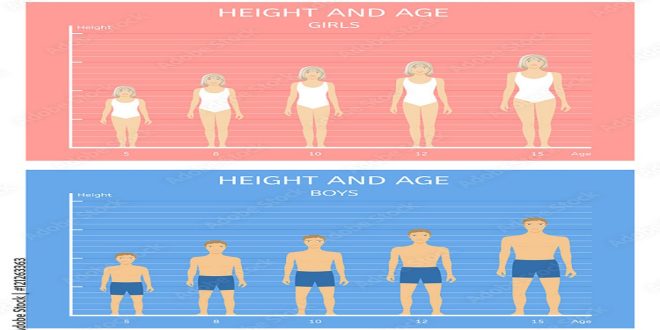Height is a significant marker of growth; it reflects overall health and development for adolescents. The average Height for a 14-year-old can vary widely due to factors like genetics, environment, nutrition, and more. This article explores the average Height for 14-year-olds worldwide, the factors influencing growth, and how teenagers can achieve their healthiest height potential.
1. Average Height for a 14-Year-Old: General Statistics
The average Height for a 14-year-old can vary greatly depending on region, genetics, and other factors. Here are some general statistics based on studies:
Boys
- The average Height for 14-year-old boys is approximately 5’4″ (162.5 cm).
- However, the average may be slightly higher in countries like the United States and parts of Europe, closer to 5’6″ (167 cm).
Girls
- For 14-year-old girls, the average Height is around 5’3″ (160 cm).
- In regions like Northern Europe, girls may be closer to 5’4″ (162.5 cm) at age 14.
Why the Variance?
- Adolescents grow at different rates due to genetics, nutrition, and environment.
- The onset of puberty, which occurs between ages 10 and 16, plays a significant role in growth. Early or late bloomers may be shorter or taller than the average for their age until they reach their final adult height.
2. Factors That Affect Height in 14-Year-Olds
Several factors influence Height during adolescence, including genetics, nutrition, physical activity, health, and sleep patterns.
A. Genetics: The Primary Determinant
- Genetics plays the most significant role in determining Height, accounting for 60-80% of a person’s height potential.
- A child’s genetic background dictates a range within which their Height is likely to fall, influenced by parental and ancestral heights.
B. Nutrition: Essential for Growth
Proper nutrition is crucial, especially during the growth spurt years around adolescence.
- Protein, calcium, vitamin D, and other minerals are vital nutrients that impact growth.
- Diets lacking in essential nutrients can stunt growth, whereas balanced diets help maximize height potential.
Nutrients and Their Roles:
- Protein: Essential for muscle and bone growth.
- Calcium: Important for strong bones, especially in growing teenagers.
- Vitamin D: Assists in calcium absorption, which is crucial for bone health.
- Other Vitamins and Minerals: Vitamins A, C, and magnesium also support growth.
C. Physical Activity and Exercise
- Physical activity stimulates the release of growth hormones, contributing to height gain.
- Weight-bearing exercises (like running and jumping) help strengthen bones.
- Activities like swimming, stretching, and yoga also support healthy posture and may contribute indirectly to a taller appearance.
D. Sleep: Rest for Growth
- During deep sleep, the body releases growth hormones that aid in development.
- Teenagers need about 8-10 hours of sleep per night to support optimal growth and overall health.
- Sleep deprivation can impact hormone levels and may slow down growth over time.
E. Health and Medical Conditions
- Chronic illnesses (such as kidney disease, celiac disease, or hormonal imbalances) can affect growth.
- Hormonal imbalances, particularly growth hormone deficiencies, can result in shorter stature if not treated.
- Other medical issues, like malabsorption, can hinder nutrient intake and impact height.
3. Puberty and Growth Spurts
A. How Puberty Impacts Growth
- Puberty triggers significant growth spurts, and its timing varies for each individual.
- Boys usually experience a growth spurt around ages 12-15, while girls often reach theirs between ages 10-13.
- This phase sees rapid height increases, with some teens growing several inches in a year.
B. Early and Late Bloomers
- “Early bloomers” experience growth spurts sooner, which can make them taller than their peers temporarily.
- Once they reach their growth spurt phase, “Late bloomers” may catch up or surpass their Height peers.
C. Final Adult Height
- Most teens stop growing around 16-18 years for girls and 18-21 years for boys, though the exact timing varies by individual.
4. Regional and Cultural Variations in Height
Height averages differ globally, influenced by genetics, lifestyle, and cultural practices:
- Europe: Northern European people (like the Netherlands) generally have some of the tallest averages.
- Asia: Height averages tend to be shorter in East Asia, although countries like South Korea and China have seen increases due to improved nutrition.
- Africa: African regions show a wide range of heights, with some of the tallest people in East African countries like Kenya and Uganda.
5. How Teens Can Support Healthy Growth
A. Balanced Diet
Encouraging a protein-rich diet, whole grains, fruits, and vegetables can positively impact Height.
B. Regular Exercise
Teens should engage in physical activity to promote strong bones and muscles.
C. Adequate Sleep
Maintaining a regular sleep schedule supports hormone function and growth.
D. Avoiding Growth Inhibitors
Smoking, alcohol, and certain drugs can stunt growth and overall health.
6. Myths and Misconceptions About Growing Taller
Several myths about Height lack scientific backing, such as:
- Supplements for Height: Most supplements marketed for height growth lack evidence. A balanced diet is usually sufficient for healthy growth.
- Stretching exercises: While stretching improves posture, it does not increase Height permanently.
8. Key Takeaways
A. Genetics
Genetics plays a leading role in determining Height. Teens with taller parents are likelier to be tall, although individual variation occurs.
B. Nutrition and Lifestyle
A balanced diet, regular exercise, and adequate sleep are essential for maximizing growth potential.
C. Puberty and Growth Patterns
Growth spurts during puberty are regular, and everyone grows at their own pace.
Conclusion
The average Height for a 14-year-old can vary significantly, and it is shaped by genetics, nutrition, and lifestyle factors. While most teens grow at a unique pace, adopting healthy habits can support optimal growth. Rather than focusing solely on Height, teens need to prioritize overall health, which, in turn, can positively impact their physical development.
FAQs
Is there an ideal height for a 14-year-old?
There is no “ideal” height, as growth varies widely. Average heights provide a benchmark, but individual growth should focus on health rather than meeting specific numbers.
Can poor posture affect Height?
Poor posture doesn’t permanently reduce Height but can make individuals appear shorter. Good posture helps one appear taller and supports spine health.
How can I tell if I’ll be tall as an adult?
Genetic factors and growth patterns during adolescence can give clues. Predictive methods, like calculating mid-parental Height, offer estimates but are not definitive.
How tall is an average 14-year-old?
The typical height for teenagers is around 5’4″ (162.5 cm) for boys and 5’3″ (160 cm) for girls. However, this may vary due to the individual’s growth patterns.
What does affect height?
To help support growth after 14 years old, focus on eating a balanced diet high in protein, regular exercise, adequate sleep, and maintaining a healthy posture. Genetics plays an important part.
Why am I short at 14?
Being smaller at 14 years old is typically due to the individual’s growth rate, genetics, or delayed puberty. Growth spurts differ, and many teens are able to catch up later.
 aim specialty health Discover Expert Insights, Empower Your Wellness With Aim Specialty Health Blogs.
aim specialty health Discover Expert Insights, Empower Your Wellness With Aim Specialty Health Blogs.




